Assessment of Phytomass and Carbon Stock in the Ecosystems of the Central Forest Steppe of the East European Plain: Integrated Approach of Terrestrial Environmental Monitoring and Remote Sensing with Unmanned Aerial Vehicles
Abstract
1. Introduction
2. Materials and Methods
2.1. Study Area
- Establishing sampling plots (Figure 2) in even-aged stands of different tree species composition and conducting the complete inventory on them with measurement of tree coordinates, species identification, trunk height and diameter, crown diameter, and tree state using ground-based inventory methods.
- Performing aerial surveys using the RGB, hyperspectral, and Lidar imagery from the UAVs to determine similar silvicultural and taxation characteristics using remote sensing methods.
- Generating training samples, designing computer vision models, and developing methods for determining the forest tree stand characteristics to calculate the phytomass of the forest stands using remote sensing methods.
- Comparing and integrating forest and taxation parameters of the stands obtained during ground-based inventories and parameters of the forest areas obtained using the RGB, hyperspectral, and UAV-based Lidar surveys.
- Application of the mathematical statistics and modelling methods to assess the accuracy of the results obtained, to verify the model validity, and to verify the developed algorithms.
- Development of the methodology for remote sensing of aboveground phytomass of forest stands for subsequent calculation of carbon stock in the forest area.
2.2. Ground-Based Forest Inventory
2.3. Estimation of the Aboveground Phytomass and Its Fractions
2.4. Flight and Survey Process
2.5. Interpretation of the Tree Stand Characteristicsfrom High-Resolution Images
- Tree canopy cover—by processing the RGB geotiffs;
- Tree height—by processing the Lidar imagery data;
- Precise tree location—by processing the Lidar imagery data;
- Tree species composition—from the RGB imagery using neural network models;
- Tree health state—with the hyperspectral data processing, based on the vegetation indices (NDVI, EVI, CVI);
- Crown diameter—using the RGB data processing and Lidar imagery;
- Stem diameter—by indirect indicators, based on the relationships identified using empirical relationships.
2.6. Remote Estimation of Aboveground Phytomass and Carbon Stocks
- UAV-based determination using machine learning models:
- Study area’s coordinates, terrain features, and delineation boundaries for forest inventory;
- “Direct” silvicultural and stand characteristics, such as composition, height, crown diameter;
- Condition and degree of debris, especially deadwood, in the stands.
- Determination of “indirect” silvicultural stand characteristics such as age, stem diameter, canopy closure, and volume stock using reference materials and allometric equations, based on “direct” silvicultural and stand characteristics values.
- Determination of the density of the undergrowth and shrub layer based on UAVs using the Lidar transect developed by the authors, as well as calculation of the phytomass of subordinate layers based on the generated tabular model.
- Calculation of the carbon stock in the aboveground part of the forest stands (living and dead vegetation phytomass). Phytomass-to-carbon conversion factors were used according to IPCC guidelines [99]: 0.51 for coniferous tree species and 0.48 for broadleaved tree species.
3. Results
3.1. Development of Technical and Methodological Tools for Determination of the Main Tree Stand Characteristics
3.1.1. State of Tree and Shrub Vegetation
3.1.2. Determining Tree Coordinates and Measurement of Stem Height and Crown Diameter
Tree Species Identification
- Manual marking was completed—the operator carried out contour and analytical interpretation, as a result of which the species composition of the forest stand was determined.
- Integration of manual marking data and RGB images.
- Formation of training samples using neural network analysis.
- Testing and calibration of machine learning models created based on neural networks.
- Hyperspectral data were used to clarify the species identity and correct the breed composition.
Determination of Crown Diameter
Determination of Tree Height and Height of Crown Base
3.1.3. Shrub Layer and Understory Phytomass Assessment
3.2. Determination of Correlations between Stand Characteristics in Order to Indirectly Identify the Deciphering Characteristics of the Forest Stand for Analytical Interpretation
3.3. Validation of the Proposed Phytomass Estimation Toolkit
3.4. Calculation of Carbon Stock from Phytomass Measurements
4. Discussion
5. Conclusions
Author Contributions
Funding
Institutional Review Board Statement
Informed Consent Statement
Data Availability Statement
Conflicts of Interest
References
- Hoegh-Guldberg, O.; Jacob, D.; Taylor, M.; Guillen Bolanos, T.; Bindi, M.; Brown, S.; Camilloni, I.; Diedhiou, A.; Djalante, R.; Ebi, K.; et al. The human imperative of stabilizing global climate change at 1.5 °C. Science 2019, 365, eaaw6974. [Google Scholar] [CrossRef] [PubMed]
- Sippel, S.; Meinshausen, N.; Fischer, E.M.; Szekely, E.; Knutti, R. Climate change now detectable from any single day of weather at global scale. Nat. Clim. Change 2020, 10, 35–41. [Google Scholar] [CrossRef]
- Malysheva, N.V.; Moiseev, B.N.; Filipchuk, A.N.; Zolina, T.A. Methods for assessing the carbon balance in forest ecosystems and the possibility of their use for calculating annual carbon sequestration. For. Bull. 2017, 21, 4–13. [Google Scholar] [CrossRef]
- Zhang, X.; Liu, D.; Ma, J.; Wang, X.; Li, Z.; Zheng, D. Visible Near-Infrared Hyperspectral Soil Organic Matter Prediction Based on Combinatorial Modeling. Agronomy 2024, 14, 789. [Google Scholar] [CrossRef]
- Braga, C.I.; Crisan, V.E.; Petritan, I.C.; Scarlatescu, V.; Vasile, D.; Lazar, G.; Petritan, A.M. Short-Term Effects of Anthropogenic Disturbances on Stand Structure, Soil Properties, and Vegetation Diversity in a Former Virgin Mixed Forest. Forests 2023, 14, 742. [Google Scholar] [CrossRef]
- Chhabra, A.; Palria, S.; Dadhwal, V.K. Spatial distribution of phytomass carbon in Indian forests. Glob. Change Biol. 2002, 8, 1230–1239. [Google Scholar] [CrossRef]
- Chen, L.; Song, M.; Song, T.-Q.; Wang, H.; Zeng, F.-P.; Peng, W.-X.; Du, H.; Han, C.; Su, L. Carbon storage and its allocation in soft broadleaved forests with different stand ages in Guangxi. Chin. J. Ecol. 2017, 36, 592–600. [Google Scholar] [CrossRef]
- Braga, C.I.; Petrea, S.; Radu, G.R.; Cucu, A.B.; Serban, T.; Zaharia, A.; Leca, S. Carbon Sequestration Dynamics in Peri-Urban Forests: Comparing Secondary Succession and Mature Stands under Varied Forest Management Practices. Land 2024, 13, 492. [Google Scholar] [CrossRef]
- Zhou, Y.; She, J.; Zhu, X. Dynamic analysis of biodiversity, carbon storage and environmental factors of coniferous forest in Loudi City, Hunan Province. Int. J. Low-Carbon Technol. 2022, 17, 831–840. [Google Scholar] [CrossRef]
- Zielonka, A.; Drewnik, M.; Musielok, Ł.; Dyderski, M.K.; Struzik, D.; Smułek, G.; Ostapowicz, K. Biotic and Abiotic Determinants of Soil Organic Matter Stock and Fine Root Biomass in Mountain Area Temperate Forests—Examples from Cambisols under European Beech, Norway Spruce, and Silver Fir (Carpathians, Central Europe). Forests 2021, 12, 823. [Google Scholar] [CrossRef]
- Bisht, S.; Bargali, S.S.; Bargali, K.; Rawat, G.S.; Rawat, Y.S.; Fartyal, A. Influence of Anthropogenic Activities on Forest Carbon Stocks—A Case Study from Gori Valley, Western Himalaya. Sustainability 2022, 14, 16918. [Google Scholar] [CrossRef]
- Diao, J.; Liu, J.; Zhu, Z.; Wei, X.; Li, M. Active forest management accelerates carbon storage in plantation forests in Lishui, southern China. For. Ecosyst. 2022, 9, 100004. [Google Scholar] [CrossRef]
- Indriyani, L.; Bana, S.; Yasin, A.; Sudia, L.B.; Kahirun; Midi, L.O. Hardin The Potential of Blue Carbon Stocks and Carbon Dioxide Absorption in Mangrove Forests to Support Low Carbon Emission Development in Southeast Sulawesi Province, Indonesia. Int. J. Adv. Sci. Eng. Inf. Technol. 2020, 10, 2526–2535. [Google Scholar] [CrossRef]
- Molotoks, A.; Stehfest, E.; Doelman, J.; Albanito, F.; Fitton, N.; Dawson, T.P.; Smith, P. Global projections of future cropland expansion to 2050 and direct impacts on biodiversity and carbon storage. Glob. Change Biol. 2018, 24, 5895–5908. [Google Scholar] [CrossRef] [PubMed]
- Payne, N.J.; Cameron, D.A.; Leblanc, J.D.; Morrison, I.K. Carbon storage and net primary productivity in Canadian boreal mixedwood stands. J. For. Res. 2019, 30, 1667–1678. [Google Scholar] [CrossRef]
- Tian, L.; Tao, Y.; Fu, W.X.; Li, T.; Ren, F.; Li, M.Y. Dynamic Simulation of Land Use/Cover Change and Assessment of Forest Ecosystem Carbon Storage under Climate Change Scenarios in Guangdong Province, China. Remote Sens. 2022, 14, 2330. [Google Scholar] [CrossRef]
- Xiao, J.F.; Chevallier, F.; Gomez, C.; Guanter, L.; Hicke, J.A.; Huete, A.R.; Ichii, K.; Ni, W.J.; Pang, Y.; Rahman, A.F.; et al. Remote sensing of the terrestrial carbon cycle: A review of advances over 50 years. Remote Sens. Environ. 2019, 233, 111383. [Google Scholar] [CrossRef]
- Strandberg, G.; Kjellström, E. Climate Impacts from Afforestation and Deforestation in Europe. Earth Interact. 2018, 23, 1–27. [Google Scholar] [CrossRef]
- Veiga, J.; Lima, A.L.; Brito, A. Effects of deforestation at different spatial scales on the climate of the Amazon basin. Clim. Res. 2023, 91, 21. [Google Scholar] [CrossRef]
- Volodkin, A.A.; Volodkina, O.A.; Larionov, M.V. Dynamics of reproduction of forest plantations in the forest-steppe zone of the Middle Volga Region. IOP Conf. Ser. Earth Environ. Sci. 2022, 979, 012101. [Google Scholar] [CrossRef]
- Chmura, D.J.; Modrzynski, J. Sensitivity of height growth response to climate change does not vary with age in common garden among Norway spruce populations from elevational gradients. For. Ecol. Manag. 2023, 542, 121118. [Google Scholar] [CrossRef]
- Sitková, Z.; Hlásny, T. Editorial to the thematic issue: Ecological interactions in Central European forest under climate change. Cent. Eur. For. J. 2020, 66, 189–190. [Google Scholar] [CrossRef]
- Vedernikov, K.E.; Bukharina, I.L.; Udalov, D.N.; Pashkova, A.S.; Larionov, M.V.; Mazina, S.E.; Galieva, A.R. The State of Dark Coniferous Forests on the East European Plain Due to Climate Change. Life 2022, 12, 1874. [Google Scholar] [CrossRef] [PubMed]
- Vinceti, B.; Manica, M.; Lauridsen, N.; Verkerk, P.J.; Lindner, M.; Fady, B. Managing forest genetic resources as a strategy to adapt forests to climate change: Perceptions of European forest owners and managers. Eur. J. For. Res. 2020, 139, 1107–1119. [Google Scholar] [CrossRef]
- Gibadulina, I.I.; Larionov, M.V.; Maslennikova, N.N. Anatomical and morphological features of the leaves of Tilia cordata Mill. as an indicator of the adaptive capabilities of the species to the conditions of the urban environment. IOP Conf. Ser. Earth Environ. Sci. 2022, 988, 032082. [Google Scholar] [CrossRef]
- Hruška, J.; Oulehle, F.; Chuman, T.; Kolář, T.; Rybníček, M.; Trnka, M.; McDowell, W.H. Forest growth responds more to air pollution than soil acidification. PLoS ONE 2023, 18, e0256976. [Google Scholar] [CrossRef]
- Larionov, M.V.; Larionov, N.V.; Siraeva, I.S.; Gromova, T.S. Ecological and aesthetic significance of an auto-trophic component of artificial ecosystems in ensuring of the environmental comfort and the public health protection. IOP Conf. Ser. Earth Environ. Sci. 2020, 421, 082002. [Google Scholar] [CrossRef]
- Larionov, M.V.; Soldatova, V.V.; Logacheva, E.A.; Larionov, N.V. An ecological analysis of the composition and condition of woody plants in urban and suburban ecosystems of the Khopyor River Region. IOP Conf. Ser. Earth Environ. Sci. 2020, 421, 062025. [Google Scholar] [CrossRef]
- Larionov, M.V.; Tarakin, A.V.; Minakova, I.V.; Sentishcheva, E.A.; Bukreeva, T.N. Creation of artificial phytocenoses with controlled properties as a tool for managing cultural ecosystems and landscapes. IOP Conf. Ser. Earth Environ. Sci. 2021, 848, 012127. [Google Scholar] [CrossRef]
- Bolte, A.; Lambertz, B.; Steinmeyer, A.; Kallweit, R.; Meesenburg, H. Zur Funktion der Bodenvegetation im Nährstoffhaushalt von Wäldern—Studien auf Dauerbeobachtungsflächen des EU Level II-Programms in Norddeutschland (The role of the herbaceous vegetation in forest nutrient cycling—Studies on permanent plots of the EU Level II program in North Germany). Forstarchiv 2004, 75, 207–220. [Google Scholar] [CrossRef]
- Davis, Z.; Nesbitt, L.; Guhn, M.; van den Bosch, M. Assessing changes in urban vegetation using Normalised Difference Vegetation Index (NDVI) for epidemiological studies. Urban For. Urban Green. 2023, 88, 128080. [Google Scholar] [CrossRef]
- Kaul, M.; Mohren, G.M.J.; Dadhwal, V.K. Phytomass carbon pool of trees and forests in India. Clim. Change 2011, 108, 243–259. [Google Scholar] [CrossRef]
- Larionov, M.V.; Volodkin, A.A.; Volodkina, O.A.; Lebedev, E.V.; Khanbabayeva, O.E.; Tazina, S.V.; Kozlova, E.A.; Orlova, E.E.; Zubik, I.N.; Bogdanova, V.D.; et al. Features of the Territorial Distribution, Composition and Structure of Phytocenoses with the Participation of Fraxinus excelsior, Their Resource Qualities, Ecological and Economic Importance (Southeastern Part of the East European Plain). Life 2023, 13, 93. [Google Scholar] [CrossRef] [PubMed]
- Lebedev, V.M.; Lebedev, E.V.; Sorokopudov, V.N.; Larionov, M.V. Root Nutrition, Photosynthesis, and Net Primary Production in Tree Stands of the genus Picea at the Organism Level within the Range in Russia. Lesn. Zhurnal 2023, 1, 38–50. [Google Scholar] [CrossRef]
- Mayer, M.; Prescott, C.E.; Abaker, W.E.A.; Augusto, L.; Cécillon, L.; Ferreira, G.W.D.; James, J.; Jandl, R.; Katzensteiner, K.; Laclau, J.-P.; et al. Tamm Review: Influence of Forest Management Activities on Soil Organic Carbon Stocks: A Knowledge Synthesis. For. Ecol. Manag. 2020, 466, 118127. [Google Scholar] [CrossRef]
- Li, D.R.; Wang, C.W.; Hu, Y.M.; Liu, S.G. General Review on Remote Sensing-Based Biomass Estimation. Geomat. Inform. Sci. Wuhan Univ. 2012, 37, 631–635. [Google Scholar] [CrossRef]
- Slavskiy, V.A.; Mironenko, A.V.; Matveev, S.M.; Litovchenko, D.A. Taxation-interpretation indicators of plantations as the basis for the development of machine learning models for remote monitoring of forests. Proc. St. Petersburg Res. Inst. For. 2022, 4, 99–114. [Google Scholar] [CrossRef]
- Ameray, A.; Bergeron, Y.; Valeria, O.; Montoro Girona, M.; Cavard, X. Forest Carbon Management: A Review of Silvicultural Practices and Management Strategies Across Boreal, Temperate and Tropical Forests. Curr. For. Rep. 2021, 7, 245–266. [Google Scholar] [CrossRef]
- Wijedasa, L.S.; Jain, A.; Ziegler, A.D.; Evans, T.A.; Fung, T. Estimating Carbon Biomass in Forests Using Incomplete Data. Biotropica 2021, 53, 397–408. [Google Scholar] [CrossRef]
- Shvidenko, A.Z.; Shepaschenko, D.G. Carbon budget of Russian forests. Sib. For. J. 2014, 1, 69–92. Available online: https://xn--80abmehbaibgnewcmzjeef0c.xn--p1ai/articles/archive/arkhiv-2014/uglerodnyy-byudzhet-lesov-rossii/ (accessed on 21 March 2024).
- Schepaschenko, D.; McCallum, I.; Shvidenko, A.; Fritz, S.; Kraxner, F.; Obersteiner, M. A new hybrid land cover dataset for Russia: A methodology for integrating statistics, remote sensing and in-situ information. J. Land Use Sci. 2011, 6, 245–259. [Google Scholar] [CrossRef]
- Pilli, R.; Alkama, R.; Cescatti, A.; Kurz, W.A.; Grassi, G. The European Forest Carbon Budget under Future Climate Conditions and Current Management Practices. Biogeosciences 2022, 19, 3263–3284. [Google Scholar] [CrossRef]
- Liang, L.; Geng, D.; Yan, J.; Qiu, S.; Shi, Y.; Wang, S.; Wang, L.; Zhang, L.; Kang, J. Remote Sensing Estimation and Spatiotemporal Pattern Analysis of Terrestrial Net Ecosystem Productivity in China. Remote Sens. 2022, 14, 1902. [Google Scholar] [CrossRef]
- Heath, L.; Nichols, M.; Smith, J.; Mills, J. FORCARB2. An Updated Version of U.S. Forest Carbon Budget Model; General Technical Report; NRS-67 USDA Forest Service, Northern Research Station: Newtown Square, PA, USA, 2010; 52p, Available online: http://nrs.fs.fed.us/pubs/35613 (accessed on 21 March 2024).
- Liu, S.; Bond-Lamberty, B.; Hicke, J.A. Simulation the impacts of disturbances on forest carbon cycling in North America: Processes, data, models and challenges. J. Geophys. Res. 2011, 116, 22. [Google Scholar] [CrossRef]
- Ma, L.; Hurtt, G.; Tang, H.; Lamb, R.; Lister, A.; Chini, L.; Dubayah, R.; Armston, J.; Campbell, E.; Duncanson, L.; et al. Spatial heterogeneity of global forest aboveground carbon stocks and fluxes constrained by spaceborne lidar data and mechanistic modeling. Glob. Change Biol. 2023, 29, 3378–3394. [Google Scholar] [CrossRef] [PubMed]
- Vahedi, A.A. Monitoring soil carbon pool in the Hyrcanian coastal plain forest of Iran: Artificial neural network application in comparison with developing traditional models. CATENA 2017, 152, 182–189. [Google Scholar] [CrossRef]
- Yu, Y.; Guo, B.; Wang, C.; Zang, W.; Huang, X.; Wu, Z.; Xu, M.; Zhou, K.; Li, J.; Yang, Y. Carbon storage simulation and analysis in Beijing-Tianjin-Hebei region based on CA-plus model under dual-carbon background. Geomat. Nat. Hazards Risk 2023, 14, 1. [Google Scholar] [CrossRef]
- Nyamukuru, A.; Whitney, C.; Tabuti, J.R.S.; Esaete, J.; Low, M. Allometric models for aboveground biomass estimation of small trees and shrubs in African savanna ecosystems. Trees For. People 2023, 11, 100377. [Google Scholar] [CrossRef]
- Sarker, M.L.R.; Nichol, J.; Iz, H.B.; Bin Ahmad, B.; Rahman, A.A. Forest Biomass Estimation Using Texture Measurements of High-Resolution Dual-Polarization C-Band SAR Data. IEEE Trans. Geosci. Remote 2013, 51, 3371–3384. [Google Scholar] [CrossRef]
- Ali, A.; Lin, S.L.; He, J.K.; Kong, F.M.; Yu, J.H.; Jiang, H.S. Climate and soils determine aboveground biomass indirectly via species diversity and stand structural complexity in tropical forests. For. Ecol. Manag. 2019, 432, 823–831. [Google Scholar] [CrossRef]
- Strategy for the Development of the Forest Complex of the Russian Federation until 2023 (Decree of the Government of the Russian Federation dated 11 February 2021 No. 312-r). Available online: https://docs.cntd.ru/document/573658653 (accessed on 1 September 2023).
- Deng, L.; Liu, S.G.; Kim, D.G.; Peng, C.H.; Sweeney, S.; Shangguan, Z.P. Past and future carbon sequestration benefits of China’s grain for green program. Glob. Environ. Change 2017, 47, 13–20. [Google Scholar] [CrossRef]
- Gong, W.; Sun, J.; Shi, S.; Yang, J.; Du, L.; Zhu, B.; Song, S. Investigating the Potential of Using the Spatial and Spectral Information of Multispectral LiDAR for Object Classification. Sensors 2015, 15, 21989–22002. [Google Scholar] [CrossRef] [PubMed]
- Slavskiy, V.A.; Matveev, S.M. Some aspects of the laying of permanent trial plots during the state inventory of forests. Lesotechnical J. 2021, 11, 56–63. [Google Scholar] [CrossRef] [PubMed]
- Huang, H.B.; Liu, C.X.; Wang, X.Y.; Zhou, X.L.; Gong, P. Integration of multi-resource remotely sensed data and allometric models for forest aboveground biomass estimation in China. Remote Sens. Environ. 2019, 221, 225–234. [Google Scholar] [CrossRef]
- Zhang, R.; Zhou, X.H.; Ouyang, Z.T.; Avitabile, V.; Qi, J.G.; Chen, J.Q.; Giannico, V. Estimating aboveground biomass in subtropical forests of China by integrating multisource remote sensing and ground data. Remote Sens. Environ. 2019, 232, 111341. [Google Scholar] [CrossRef]
- Zhang, Y.Z.; Liang, S.L.; Yang, L. A Review of Regional and Global Gridded Forest Biomass Datasets. Remote Sens. 2019, 11, 2744. [Google Scholar] [CrossRef]
- Chopping, M.; Wang, Z.S.; Schaaf, C.; Bull, M.A.; Duchesne, R.R. Forest aboveground biomass in the southwestern United States from a MISR multi-angle index, 2000–2015. Remote Sens. Environ. 2022, 275, 112964. [Google Scholar] [CrossRef]
- Li, Y.; Xiao, J.; Cong, N.; Yu, X.; Lin, Y.; Liu, T.; Qi, G.; Ren, P. Modeling Ecological Resilience of Alpine Forest under Climate Change in Western Sichuan. Forests 2023, 14, 1769. [Google Scholar] [CrossRef]
- Zhang, Z.; Tian, X.; Chen, R.X.; He, Q.S. Review of methods on estimating forest above ground biomass. J. Beijing For. Univ. 2011, 33, 144–150. Available online: https://www.researchgate.net/publication/286837566_Review_of_methods_on_estimating_forest_above_ground_biomass (accessed on 21 March 2024).
- Demina, N.A.; Karpov, A.A.; Voronin, V.V.; Lopatin, E.V.; Bogdanov, A.P. Possible use of remote sensing for reforestation processes in Arctic zone of European Russia. Arct. Environ. Res. 2018, 18, 106–113. [Google Scholar] [CrossRef]
- Malysheva, N.V.; Zolina, T.A.; Dedova, V.Y. Estimation of carbon accumulation by Russian forests: Geospatial aspect. InterCarto InterGIS 2017, 1, 373–382. [Google Scholar] [CrossRef][Green Version]
- Filipchuk, A.N.; Moiseev, B.N.; Malysheva, N.V. Methodology for taking into account the absorption of CO2 by forests in Russia. In Proceedings of the 2nd International Scientific and Technical Conference “Forests of Russia: Politics, Industry, Science, Education”, St. Petersburg, Russia, 24–26 May 2017; Volume 2, pp. 155–158. [Google Scholar]
- Baccini, A.; Walker, W.; Carvalho, L.; Farina, M.; Sulla-Menashe, D.; Houghton, R.A. Tropical forests are a net carbon source based on aboveground measurements of gain and loss. Science 2017, 358, 230–233. [Google Scholar] [CrossRef] [PubMed]
- Beaudoin, A.; Bernier, P.Y.; Guindon, L.; Villemaire, P.; Guo, X.J.; Stinson, G.; Bergeron, T.; Magnussen, S.; Hall, R.J. Mapping attributes of Canada’s forests at moderate resolution through kNN and MODIS imagery. Can. J. For. Res. 2014, 44, 521–532. [Google Scholar] [CrossRef]
- Dube, T.; Mutanga, O. Evaluating the utility of the medium-spatial resolution Landsat 8 multispectral sensor in quantifying aboveground biomass in uMgeni catchment, South Africa. ISPRS J. Photogramm. 2015, 101, 36–46. [Google Scholar] [CrossRef]
- Powell, S.L.; Cohen, W.B.; Healey, S.P.; Kennedy, R.E.; Moisen, G.G.; Pierce, K.B.; Ohmann, J.L. Quantification of live aboveground forest biomass dynamics with Landsat time-series and field inventory data: A comparison of empirical modeling approaches. Remote Sens. Environ. 2010, 114, 1053–1068. [Google Scholar] [CrossRef]
- Fremout, T.; Vinatea, J.C.D.; Thomas, E.; Huaman-Zambrano, W.; Salazar-Villegas, M.; de la Fuente, D.L.; Bernardino, P.N.; Atkinson, R.; Csaplovics, E.; Muys, B. Site-specific scaling of remote sensing-based estimates of woody cover and aboveground biomass for mapping long-term tropical dry forest degradation status. Remote Sens. Environ. 2022, 276, 113040. [Google Scholar] [CrossRef]
- Fan, W.Y.; Li, M.Z.; Yang, J.M. Forest Biomass Estimation Models of Remote Sensing in Changbai Mountain Forests. Sci. Silvae Sinicae 2011, 47, 16–20. [Google Scholar] [CrossRef]
- Hopkinson, C.; Chasmer, L.; Gynan, C.; Mahoney, C.; Sitar, M. Multisensor and Multispectral LiDAR Characterization and Classification of a Forest Environment. Can. J. Remote Sens. 2016, 42, 501–520. [Google Scholar] [CrossRef]
- Zou, X.; Zhao, G.; Li, J.; Yang, Y.; Fang, Y. 3D Land Cover Classification Based on Multispectral Lidar Point Clouds. Int. Arch. Photogramm. Remote Sens. Spatial Inf. Sci. 2016, XLI-B1, 741–747. [Google Scholar] [CrossRef]
- Kukkonen, M.; Maltamo, M.; Korhonen, L.; Packalen, P. Multispectral Airborne LiDAR Data in the Prediction of Boreal Tree Species Composition. IEEE Trans. Geosci. Remote Sens. 2019, 57, 3462–3471. [Google Scholar] [CrossRef]
- Dalponte, M.; Ene, L.T.; Gobakken, T.; Næsset, E.; Gianelle, D. Prediction of Forest Attributes with Multispectral Lidar Data. In Proceedings of the IGARSS 2018—2018 IEEE International Geoscience and Remote Sensing. Symposium, Valencia, Spain, 22–27 July 2018; pp. 7528–7531. [Google Scholar] [CrossRef]
- Dalla Corte, A.P.; Souza, D.V.; Rex, F.E.; Sanquetta, C.R.; Mohan, M.; Silva, C.A.; Almeyda-Zambrano, A.M.; Prata, G.; de Almeida, D.R.; Trautenmüller, J.W.; et al. Forest inventory with high-density UAV-Lidar: Machine learning approaches for predicting individual tree attributes. Comput. Electron. Agric. 2020, 179, 105815. [Google Scholar] [CrossRef]
- Immitzera, M.; Stepperb, C.; Böcka, S.; Straubb, C.; Atzbergera, C. Use of WorldView-2 stereo imagery and National Forest Inventory data for wall-to-wall mapping of growing stock. For. Ecol. Manag. 2016, 359, 232–246. [Google Scholar] [CrossRef]
- Shang, C.; Coops, N.C.; Wulder, M.A.; White, J.C.; Hermosilla, T. Update and spatial extension of strategic forest inventories using time series remote sensing and modeling. Int. J. Appl. Earth Obs. Geoinf. 2020, 84, 1229–1241. [Google Scholar] [CrossRef]
- Liang, X.; Hyyppä, J.; Kaartinen, H.; Lehtomäki, M.; Pyörälä, J.; Pfeifer, N.; Holopainen, M.; Brolly, G.; Pirotti, F.; Hackenberg, J.; et al. International benchmarking of terrestrial laser scanning approaches for forest inventories. ISPRS J. Photogramm. Remote Sens. 2018, 144, 137–179. [Google Scholar] [CrossRef]
- Noordermeer, L.; Gobakken, T.; Næsset, E.; Bollandsas, O.-M. Predicting and mapping site index in operational forest inventories using bitemporal airborne laser scanner data. For. Ecol. Manag. 2020, 457, 117768. [Google Scholar] [CrossRef]
- Lu, D.S.; Chen, Q.; Wang, G.X.; Liu, L.J.; Li, G.Y.; Moran, E. A survey of remote sensing-based aboveground biomass estimation methods in forest ecosystems. Int. J. Digit. Earth. 2016, 9, 63–105. [Google Scholar] [CrossRef]
- Morsy, S.; Shaker, A.; El-Rabbany, A.; LaRocque, P.E. Airborne multispectral lidar data for land-cover classification and land/water mapping using different spectral indexes. ISPRS Ann. Photogramm. Remote Sens. Spat. Inf. Sci. 2016, 3, 217–224. [Google Scholar] [CrossRef]
- Budei, B.C.; St-Onge, B.; Hopkinson, C.; Audet, F.A. Identifying the genus or species of individual trees using a three-wavelength airborne lidar system. Remote Sens. Environ. 2018, 204, 632–647. [Google Scholar] [CrossRef]
- Ekhtari, N.; Glennie, C.; Fernandez-Diaz, J.C. Classification of Airborne Multispectral Lidar Point Clouds for Land Cover Mapping. IEEE J. Sel. Top. Appl. Earth Obs. Remote Sens. 2018, 11, 2068–2078. [Google Scholar] [CrossRef]
- Wichmann, V.; Bremer, M.; Lindenberger, J.; Rutzinger, M.; Georges, C.; Petrini-Monteferri, F. Evaluating the potential of multispectral airborne lidar for topographic mapping and land cover classification. ISPRS Ann. Photogram. Remote Sens. Spat. Inform. Sci. 2015, 3, 113–119. [Google Scholar] [CrossRef]
- Shokurov, A.V. System for remote size-adaptive variable detail raster image fragment retriever. Probl. Inform. 2012, 1, 25–39. Available online: https://cyberleninka.ru/article/n/sistema-udalennogo-izvlecheniya-fragmenta-rastrovogo-izobrazheniya-izmenyaemoy-detalizatsii-adaptirovannaya-k-ego-razmeru (accessed on 21 March 2024).
- Shokurov, A.V. Irregularly Detailed Raster Image Coding Software Design with Respect to Adaptive and Interactive Image Analysis. Softw. Eng. 2011, 5, 17–28. Available online: http://iipo.tu-bryansk.ru/fileadmin/user_upload/_content_admins/Journal_PrI/ZHurnal_Programmnaja_Inzhenerija_2011_No_5.pdf (accessed on 21 March 2024).
- Rules of Sanitary Safety in Forests: Decree of the Government of the Russian Federation of 9 December 2020 No. 2047. On the Rules of Sanitary Safety in Forests//Collection of Legislation. 2020. Available online: http://docs.cntd.ru/document/436736467 (accessed on 1 September 2023).
- Lukina, N.V.; Tikhonova, E.V.; Danilova, M.A.; Bakhmet, O.N.; Kryshen, A.M.; Tebenkova, D.N.; Kuznetsova, A.I.; Smirnov, V.E.; Braslavskaya, T.Y.; Gornov, A.V.; et al. Associations between forest vegetation and the fertility of soil organic horizons in northwestern Russia. For. Ecosyst. 2019, 6, 34. [Google Scholar] [CrossRef]
- Order of the Federal Forestry Agency. On Approval of Guidelines for the State Forest Inventory. 10 November 2011. Available online: http://docs.cntd.ru/document/436736785 (accessed on 3 September 2023).
- Slavskiy, V.; Litovchenko, D.; Matveev, S.; Sheshnitsan, S.; Larionov, M.V. Assessment of Biological and Environmental Factors Influence on Fire Hazard in Pine Forests: A Case Study in Central Forest-Steppe of the East European Plain. Land 2023, 12, 103. [Google Scholar] [CrossRef]
- Order of the Ministry of Natural Resources and Ecology of the Russian Federation dated December 29, 2021 No. 1024 “On Approval of the Rules for Reforestation, the Form, Composition, Procedure for Approving a Reforestation Project, Grounds for Refusing to Approve it, as well as Requirements for the Format in the Electronic Form of a Reforestation Project”. Available online: https://docs.cntd.ru/document/728111110 (accessed on 4 September 2023).
- On Approval of the Forest Management Instruction/Order of the Ministry of Natural Resources of Russia (Ministry of Natural Resources and Ecology of the Russian Federation) dated August 05 2022 No. 510. Available online: http://publication.pravo.gov.ru/Document/View/0001202209300058 (accessed on 4 September 2023).
- Usoltsev, V.A.; Shobairi, S.O.R.; Chasovskikh, V.P. Comparing of Allometric Models of Single-tree Biomass Intended for Airborne Laser Sensing and Terrestrial Taxation of Carbon Pool in the Forests of Eurasia. Nat. Resour. Model. 2019, 32, e12187. [Google Scholar] [CrossRef]
- Utkin, A.I.; Zamolodchikov, D.G.; Gulbe, T.A.; Gulbe, Y.A. Allometric equations for phytomass based on the data on pine, spruce, birch and aspen trees in European Russia. Lesovedenie 1996, 6, 36–46. Available online: https://elibrary.ru/item.asp?id=21266850 (accessed on 21 March 2024).
- STATISTICA (13.0-StatSoft, 2021). Available online: https://statsoftstatistica.ru/ (accessed on 4 September 2023).
- Tian, X.; Yan, M.; van der Tol, C.; Li, Z.; Su, Z.B.; Chen, E.X.; Li, X.; Li, L.H.; Wang, X.F.; Pan, X.D.; et al. Modeling forest above-ground biomass dynamics using multi-source data and incorporated models: A case study over the qilian mountains. Agric. For. Meteorol. 2017, 246, 1–14. [Google Scholar] [CrossRef]
- Mehtatalo, L.; Lappi, J. Biometry for Forestry and Environmental Data: With Examples in R, 1st ed.; Chapman and Hall/CRC: New York, NY, USA, 2020. [Google Scholar] [CrossRef]
- Lüdecke, D.; Makowski, D.; Waggoner, P.; Patil, I. Assessment of Regression Models Performance; CRAN: Indianapolis, IN, USA, 2020. [Google Scholar] [CrossRef]
- Wang, J.; Yan, M.; Huang, Q.; Huang, R.; Zheng, Q. Diameter Distribution of Semi-natural Mixed Forest of Pinus massoniana and Broadleaved Trees Based on Stratification. For. Res. 2021, 34, 72–80. [Google Scholar] [CrossRef]
- Yu, C.; Mao, J.-H.; Huang, X.; Zhang, Y. Carbon capture by phytomass storage and trading to mitigate climate change and preserve natural resources. Environ. Sustain. Indic. 2024, 22, 100358. [Google Scholar] [CrossRef]
- GOST R 59328-2021 Topographic Aerial Photography. “Technical Requirements”. Standartinform. 2021. Available online: https://rkc56.ru/attach/orenburg/docs/kodeks/gost_r_59328-2021-aerofotosemka.pdf (accessed on 4 September 2023).
- Yang, B.; Zhang, W.; Lu, Y.; Zhang, W.; Wang, Y. Carbon Storage Dynamics of Secondary Forest Succession in the Central Loess Plateau of China. Forests 2019, 10, 342. [Google Scholar] [CrossRef]
- Fatehi, P.; Damm, A.; Schaepman, M.E.; Kneubuhler, M. Estimation of Alpine Forest Structural Variables from Imaging Spectrometer Data. Remote Sens. 2015, 7, 16315–16338. [Google Scholar] [CrossRef]
- Zhang, G.; Ganguly, S.; Nemani, R.R.; White, M.A.; Milesi, C.; Hashimoto, H.; Wang, W.L.; Saatchi, S.; Yu, Y.F.; Myneni, R.B. Estimation of forest aboveground biomass in California using canopy height and leaf area index estimated from satellite data. Remote Sens. Environ. 2014, 151, 44–56. Available online: https://scholar.google.com/scholar_lookup?title=Estimation+of+forest+aboveground+biomass+in+California+using+canopy+height+and+leaf+area+index+estimated+from+satellite+data&author=Zhang,+G.&author=Ganguly,+S.&author=Nemani,+R.R.&author=White,+M.A.&author=Milesi,+C.&author=Hashimoto,+H.&author=Wang,+W.L.&author=Saatchi,+S.&author=Yu,+Y.F.&author=Myneni,+R.B.&publication_year=2014&journal=Remote+Sens.+Environ.&volume=151&pages=44%E2%80%9356&doi=10.1016/j.rse.2014.01.025 (accessed on 10 February 2024). [CrossRef]
- Levick, S.R.; Shendryk, Y.; Setterfield, S.A.; Rossiter-Rachor, N.A. Evaluation of Satellite Remote Sensing Pathways for Mapping and Monitoring of Gamba Grass for the Savanna Fire Management Methodology; CSIRO and Charles Darwin University: Darwin, Australia, 2018; Volume 20, 27p, Available online: https://nesplandscapes.edu.au/wp-content/uploads/2019/10/Evaulation-of-remote-sensing-for-mapping-monitoring-gamba.pdf (accessed on 10 February 2024).
- Hill, S.; Latifi, H.; Heurich, M.; Müller, J. Individual-tree- and stand-based development following natural disturbance in a heterogeneously structured forest: A LiDAR-based approach. Ecol. Inform. 2017, 38, 12–25. [Google Scholar] [CrossRef]
- Marselis, S. Mapping Forest Fuel Structure with LiDAR; Australian National University Press: Canberra, Australia, 2014; pp. 1–35. [Google Scholar]
- Pierfranco Costabile, P.; Carmelina Costanzo, C.; Gianluca De Lorenzo, G.; De Santis, R.; Penna, N.; Macchione, F. Terrestrial and airborne laser scanning and 2-D modelling for 3-D flood hazard maps in urban areas: New opportunities and perspectives. Environ. Model. Softw. 2021, 135, 104889. [Google Scholar] [CrossRef]
- Patil, P.; Dutta, D.; Biradar, C.; Singh, M. Quantification of the terrestrial phytomass and carbon in the mountainous forest ecosystem using remote sensing and in-situ observations. Int. Arch. Photogramm. Remote Sens. Spatial Inf. Sci. 2015, XL-7/W3, 483–487. [Google Scholar] [CrossRef]
- Heyojoo, B.P.; Nandy, S. Estimation of above-ground phytomass and carbon in tree resources outside the forest (TROF): A geo-spatial approach. Banko Janakari 2015, 24, 34–40. [Google Scholar] [CrossRef][Green Version]
- Tian, L.; Wu, X.; Tao, Y.; Li, M.; Qian, C.; Liao, L.; Fu, W. Review of Remote Sensing-Based Methods for Forest Aboveground Biomass Estimation: Progress, Challenges, and Prospects. Forests 2023, 14, 1086. [Google Scholar] [CrossRef]
- Reinmann, A.B.; Smith, I.A.; Thompson, J.R.; Hutyra, L.R. Urbanization and fragmentation mediate temperate forest carbon cycle response to climate. Environ. Res. Lett. 2020, 15, 114036. [Google Scholar] [CrossRef]
- Zhao, J.; Liu, D.; Zhu, Y.; Peng, H.; Xie, H. A review of forest carbon cycle models on spatiotemporal scales. J. Clean. Prod. 2022, 339, 130692. [Google Scholar] [CrossRef]
- Liu, D.; Yan, H.; Yu, C.L.; Yin, S.P.; Wang, C.W.; Gong, L.J. Quantitative Assessment of Climate Change Impacts on Forest Ecosystems Get access Arrow. For. Sci. 2022, 69, 143–157. [Google Scholar] [CrossRef]
- Singh, K.; Sharma, P.C. Above-ground tree outside forest (TOF) phytomass and carbon estimation in the semi-arid region of southern Haryana: A synthesis approach of remote sensing and field data. J. Earth Syst. Sci. 2013, 121, 1469–1482. [Google Scholar] [CrossRef]
- Suthari, S.; Raju, V.S.; Singh, S. An assessment of the aboveground phytomass and carbon levels of the forests of northern Telangana, India, using a geospatial technique. Biodiversity 2020, 21, 227–237. [Google Scholar] [CrossRef]
- Mudrák, O.; Angst, Š.; Angst, G.; Veselá, H.; Schnablová, R.; Herben, T.; Frouz, J. Ecological significance of standing dead phytomass: Marcescence as a puzzle piece to the nutrient cycle in temperate ecosystems. J. Ecol. 2023, 111, 2245–2256. [Google Scholar] [CrossRef]
- Nandy, S.; Ghosh, S.; Kushwaha, S.P.S.; Senthil Kumar, A. Remote Sensing-Based Forest Biomass Assessment in Northwest Himalayan Landscape. In Remote Sensing of Northwest Himalayan Ecosystems; Navalgund, R., Kumar, A., Nandy, S., Eds.; Springer: Singapore, 2017. [Google Scholar] [CrossRef]
- Schiffman, P.M.; Johnson, W.C. Phytomass and detrital carbon storage during forest regrowth in the southeastern United States Piedmont. Can. J. For. Res. 2011, 19, 69–78. [Google Scholar] [CrossRef]
- Hetemäki, L.; Jyrki, K.; Peltola, H. (Eds.) Forest Bioeconomy and Climate Change; Series: Managing Forest Ecosystems, MAFE; Springer Nature Switzerland AG: Cham, Switzerland, 2022; Volume 42, 257p. [Google Scholar] [CrossRef]
- Ho, K.V.; Kröel-Dulay, G.; Tölgyesi, C.; Bátori, Z.; Tanács, E.; Kertész, M.; Török, P.; Erdős, L. Non-native tree plantations are weak substitutes for near-natural forests regarding plant diversity and ecological value. For. Ecol. Manag. 2023, 531, 120789. [Google Scholar] [CrossRef]
- Sena, K.N.; Maltoni, K.; Troleis, M.J.B.; Faria, G.A. Forest harvest management systems and residual phytomass affecting physical properties of a sandy soil. Rev. Bras. de Ciência do Solo 2021, 45, e0200190. [Google Scholar] [CrossRef]
- Zhao, H.; Zhao, D.; Jiang, X.; Zhang, S.; Lin, Z. Assessment of Urban Forest Ecological Benefit Based on the i-Tree Eco Model—A Case Study of Changchun Central City. Forests 2023, 14, 1304. [Google Scholar] [CrossRef]

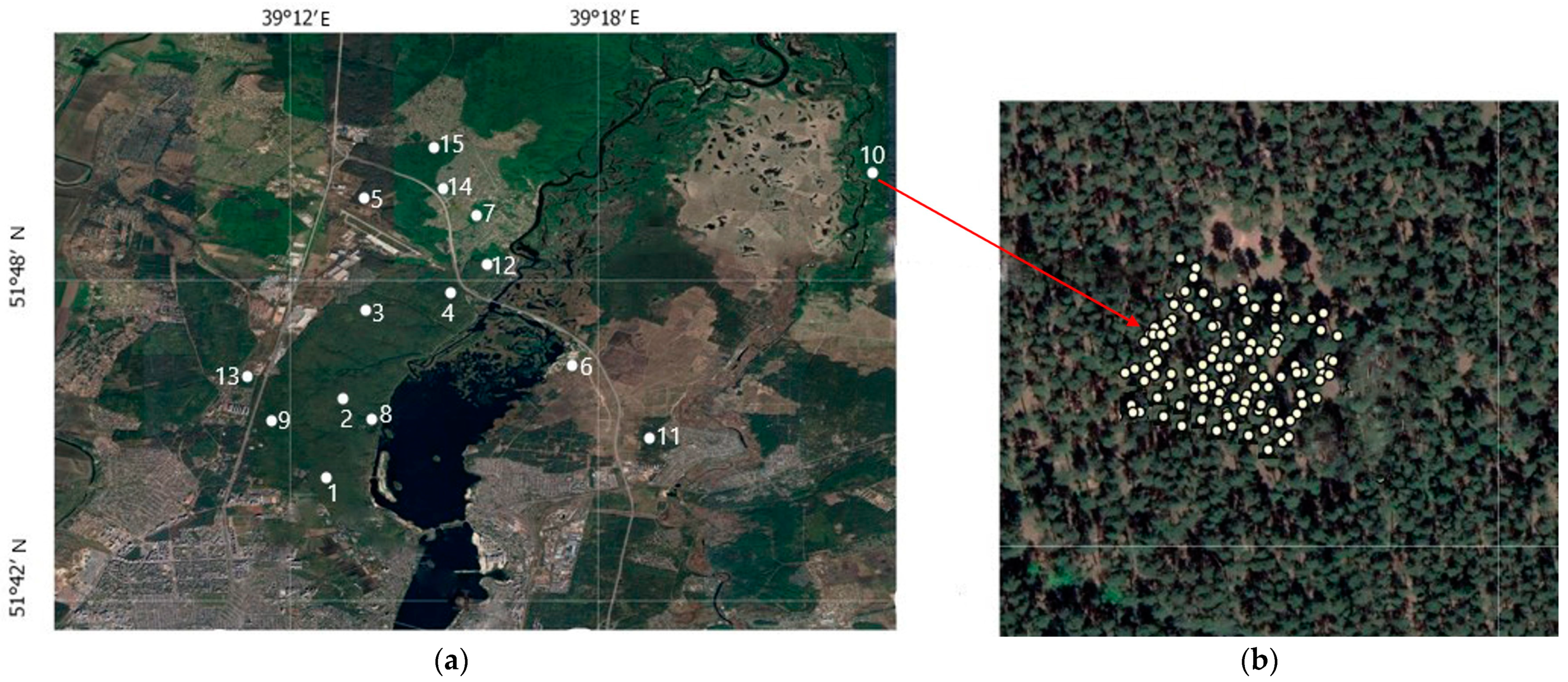

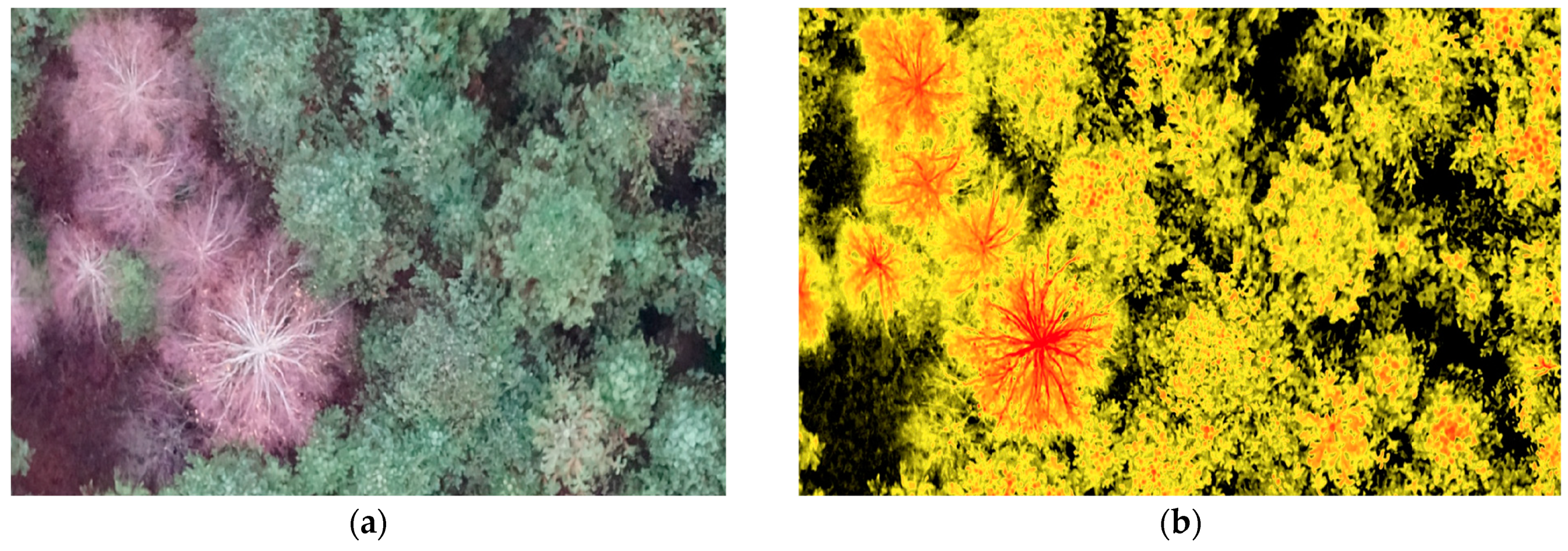


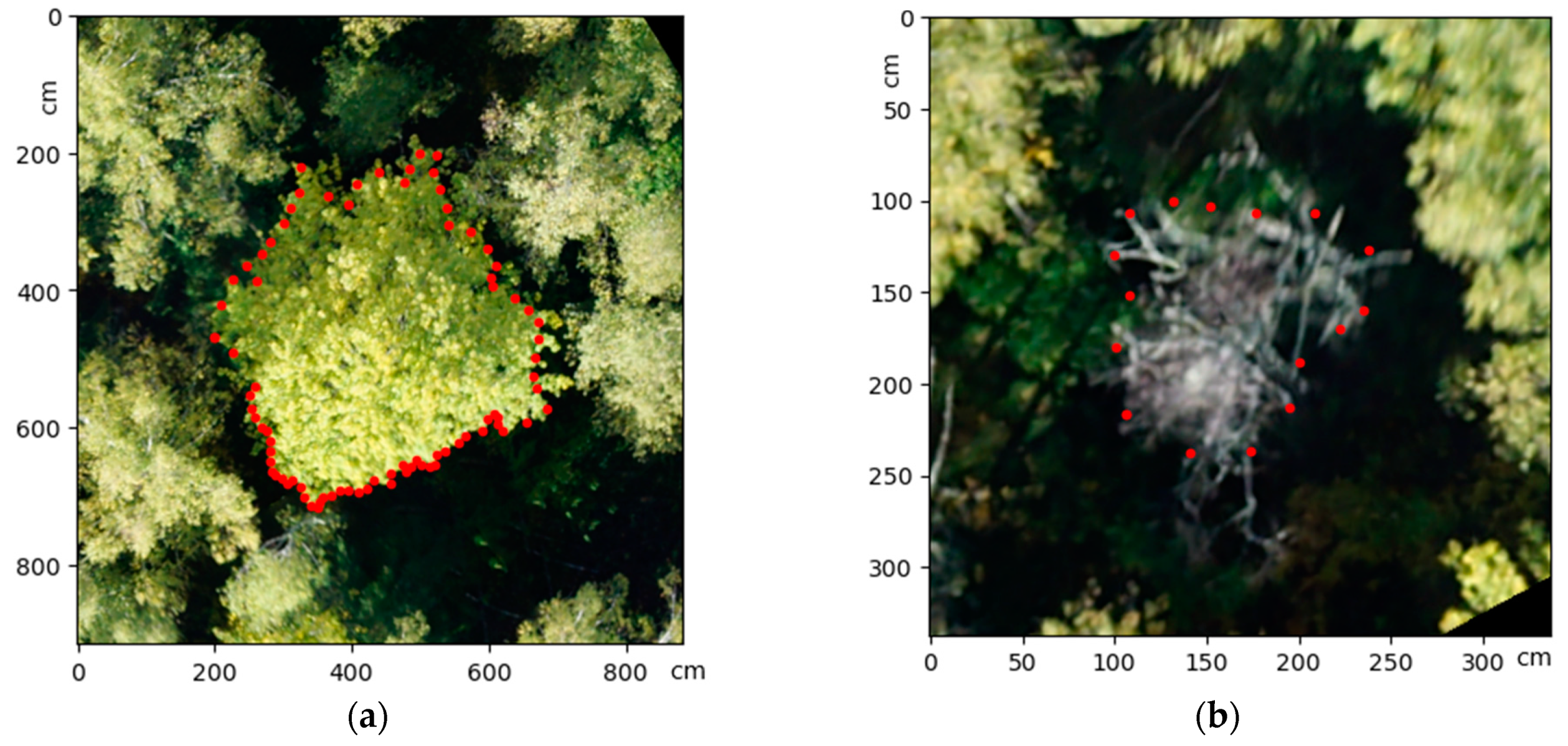
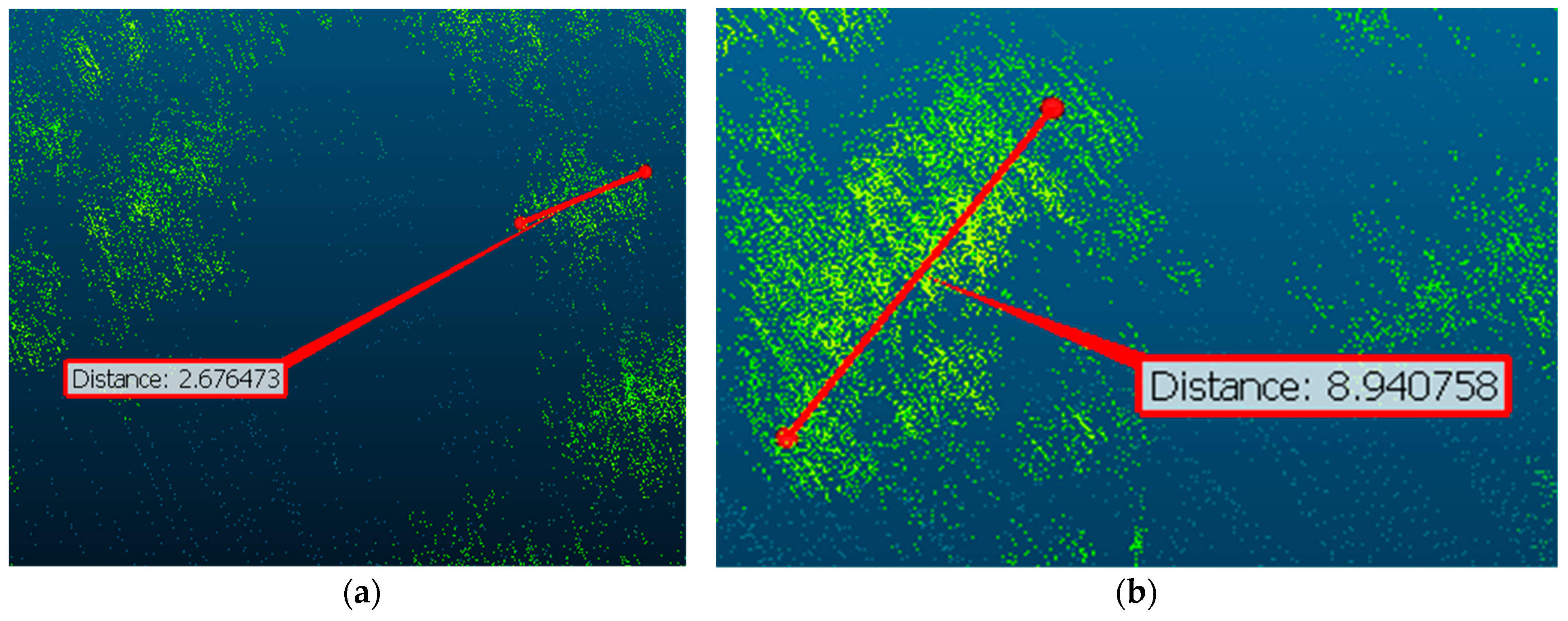
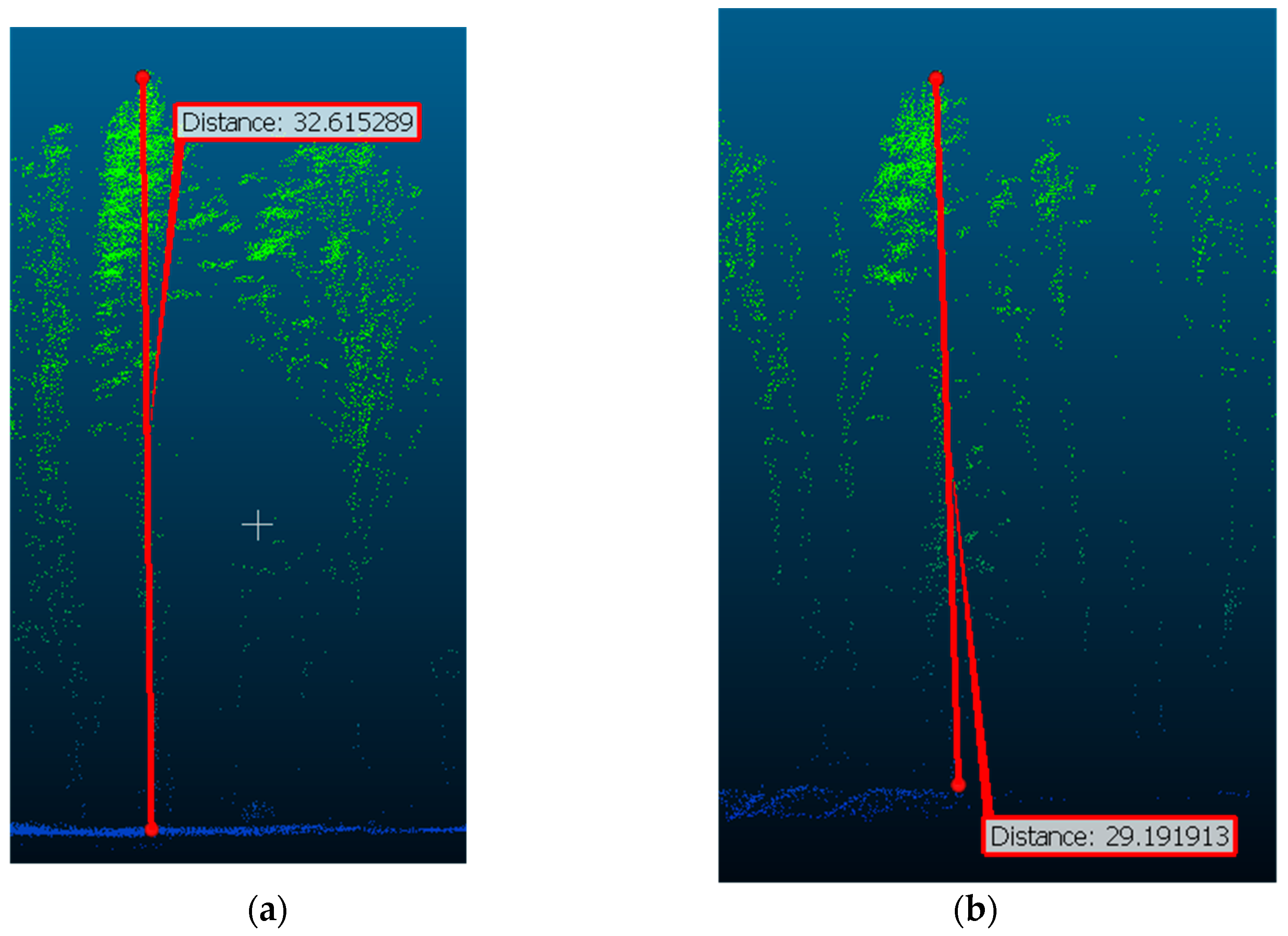

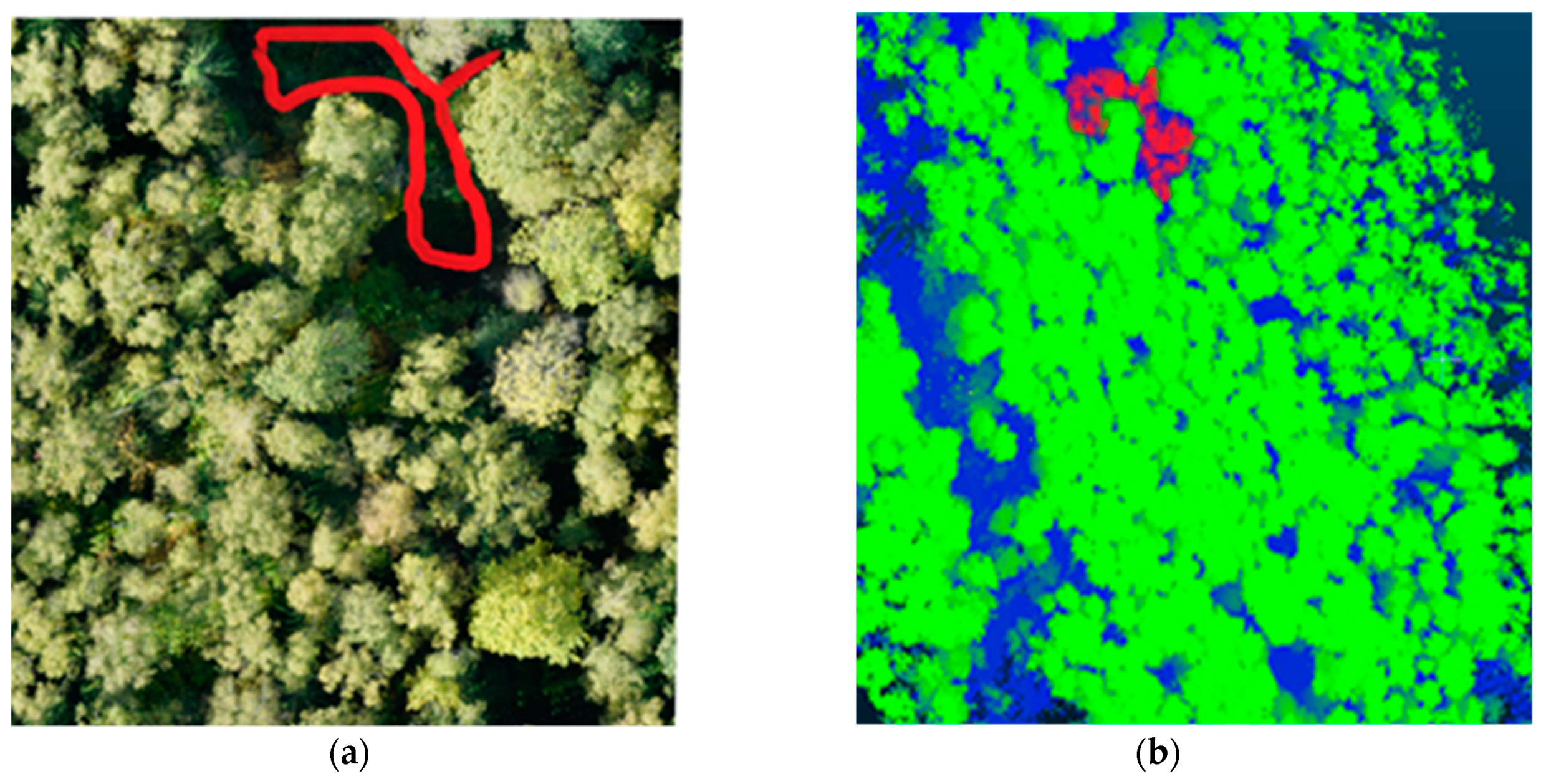

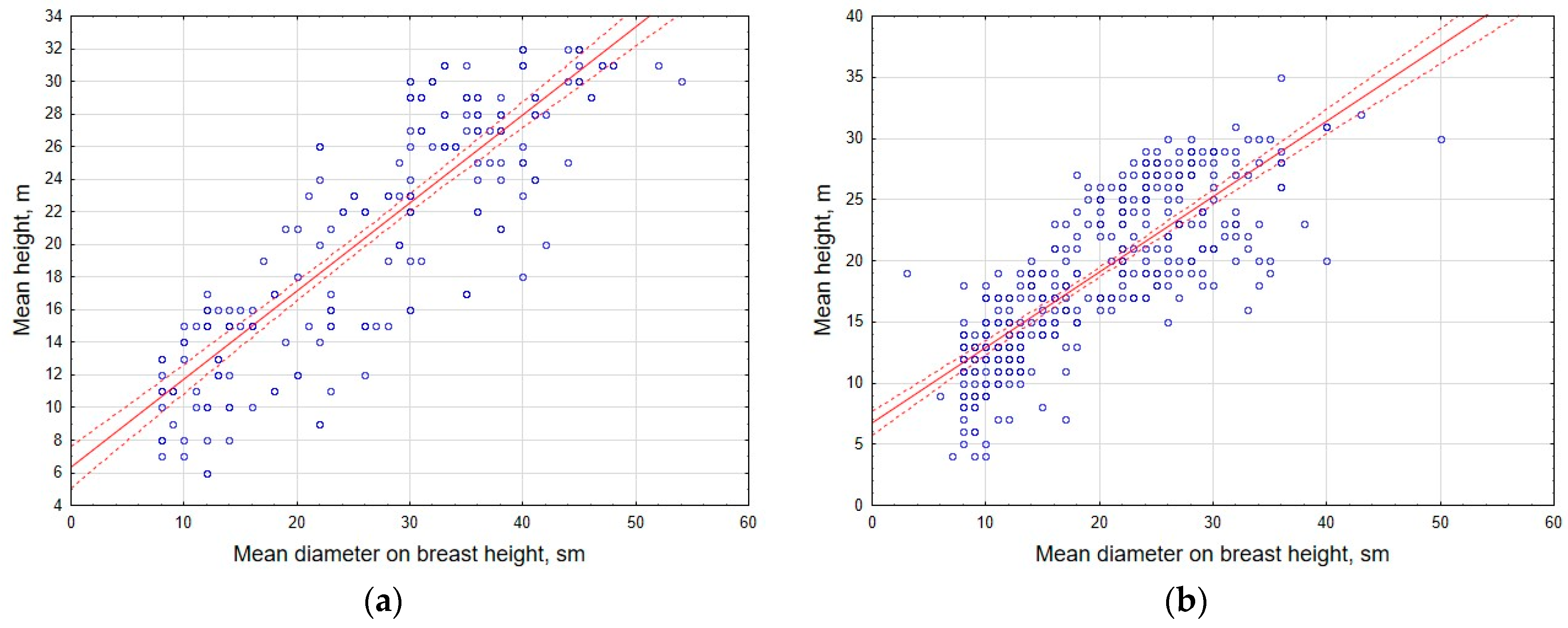


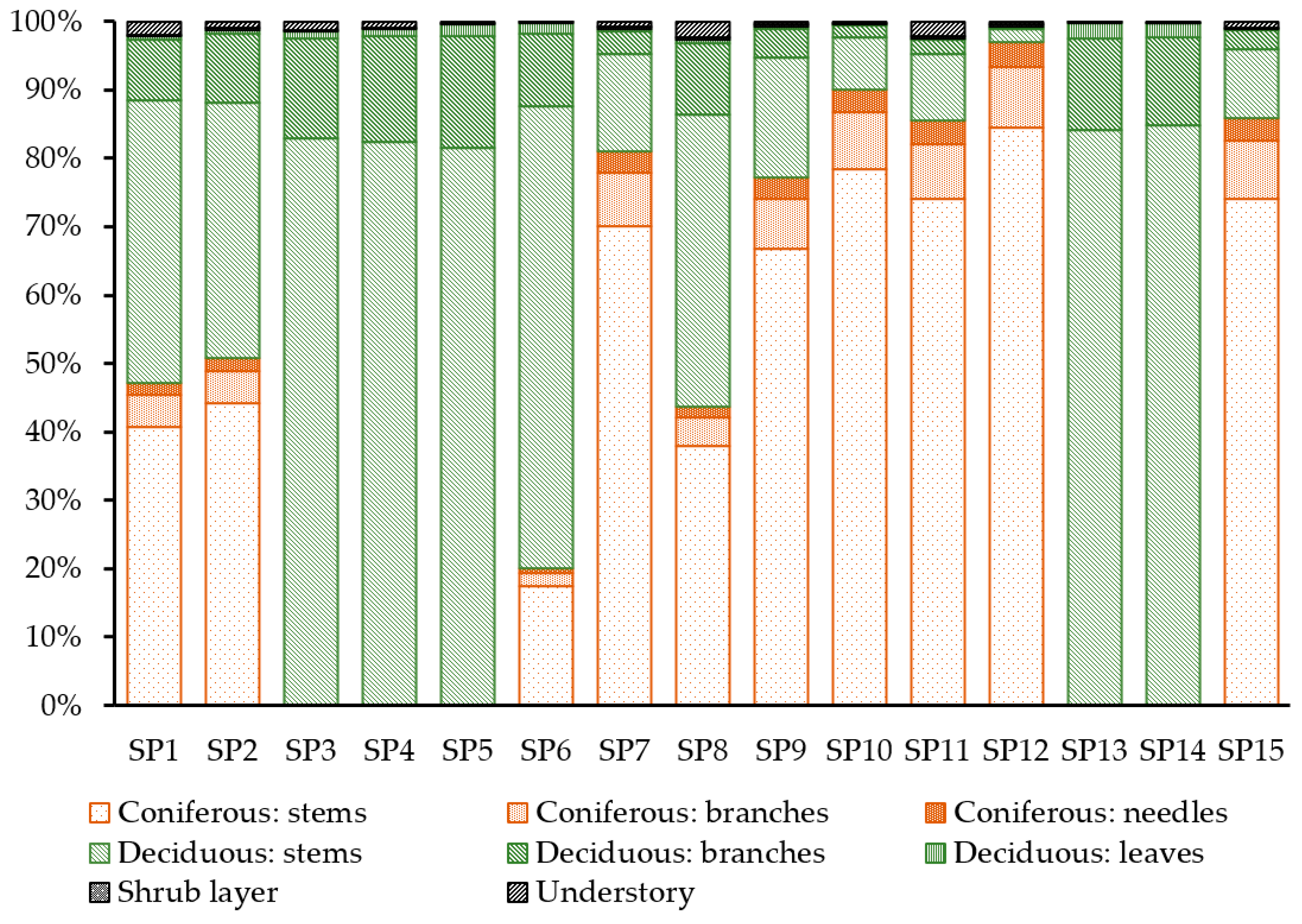
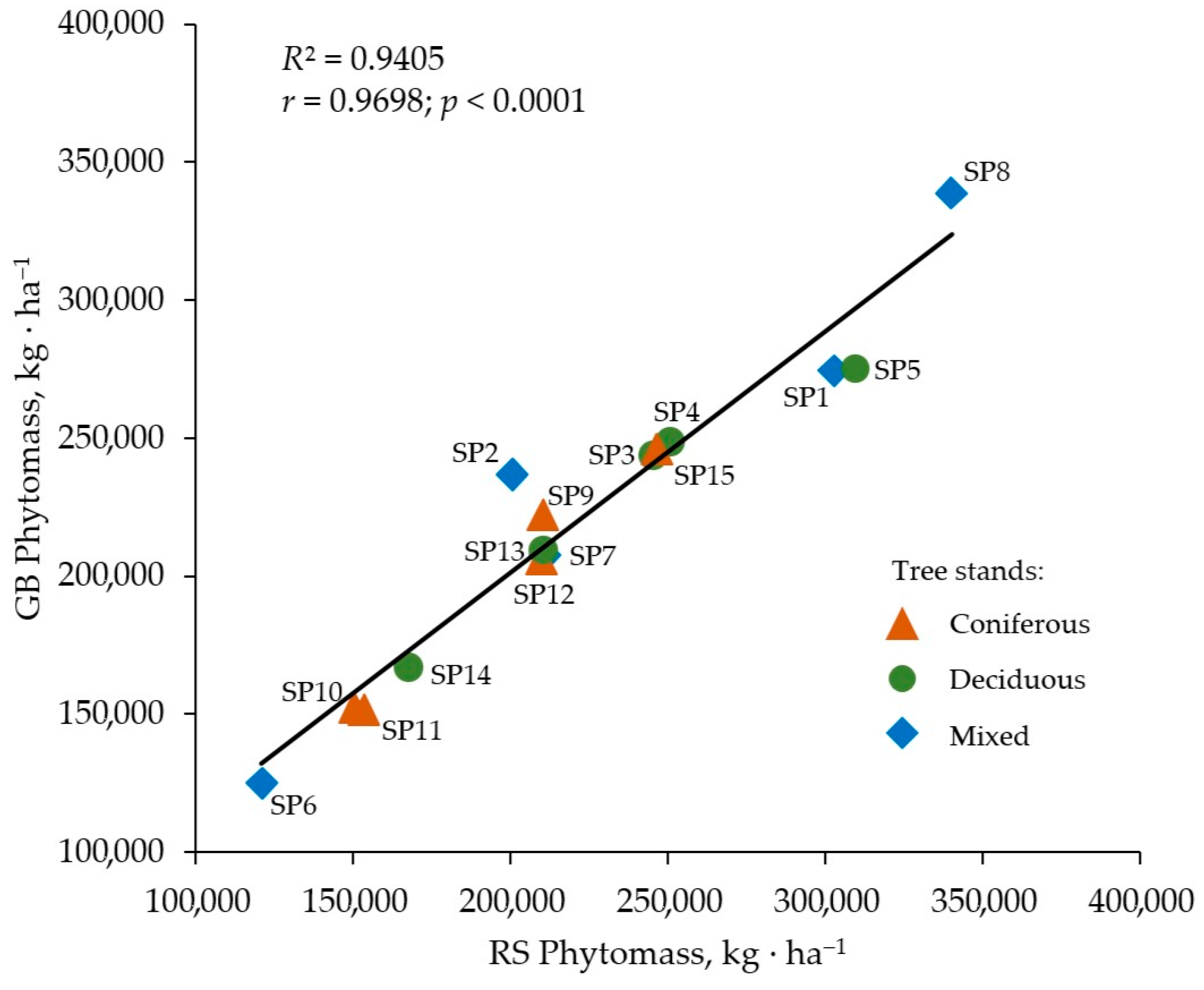
| No of Sample Plot | Location | Composition of Tree Species, % | Age, Years | DBH, cm | H, m | f | Volume Stock, m3 ha−1 | FGC |
|---|---|---|---|---|---|---|---|---|
| 1 | Quarter 44; site 26 | 70% Scots pine 30% English oak | 90 | 35 | 27 | 0.6 | 266 | C2 |
| 2 | Quarter 51; site 44 | 80% Scots pine 20% English oak | 90 | 31 | 28 | 0.6 | 220 | C2 |
| 3 | Quarter 27; site 14 | 90% English oak 10% Linden | 90 | 30 | 26 | 0.6 | 250 | C2D |
| 4 | Quarter 11; site 25 | 80% English oak 20% English oak | 90 | 28 | 24 | 0.6 | 210 | D2 |
| 5 | Quarter 6; site 11 | 100% European birch | 85 | 40 | 28 | 0.6 | 210 | C2D |
| 6 | Quarter 110; site 13 | 90% European birch 10% Scots pine | 75 | 22 | 23 | 0.7 | 190 | A2 |
| 7 | Quarter 9; site 28 | 80% Scots pine 20% European birch | 90 | 30 | 26 | 0.7 | 310 | C2 |
| 8 | Quarter 46; site 10 | 80% Scots pine 20% English oak | 90 | 32 | 28 | 0.8 | 350 | B2 |
| 9 | Quarter 48; site 44 | 80% Scots pine 20% Scots pine | 90 | 30 | 24 | 0.8 | 330 | A2 |
| 10 | Quarter 6; site 3 | 100% Scots pine | 90 | 28 | 25 | 0.7 | 320 | A2 |
| 11 | Quarter 76; site 21 | 100% Scots pine | 90 | 30 | 26 | 0.6 | 290 | A2 |
| 12 | Quarter 78; site 7 | 100% Scots pine | 90 | 31 | 28 | 0.7 | 350 | B2 |
| 13 | Quarter 48; site 79 | 100% Aspen | 95 | 32 | 26 | 0.7 | 290 | C2D |
| 14 | Quarter 8; site 10 | 100% Aspen | 100 | 30 | 26 | 0.6 | 230 | C2D |
| 15 | Quarter 48; site 17 | 100% Scots pine | 95 | 32 | 28 | 0.7 | 350 | B2 |
| Vegetation Index | Indicator Value in the Red Area | Indicator Value in the Yellow Area |
|---|---|---|
| NDVI | 0.0515 | 0.6944 |
| CVI | 1.1382 | 2.9996 |
| Criteria | Density Degree, pcs. ha−1 | ||||||||
|---|---|---|---|---|---|---|---|---|---|
| Dense (More than 5000) | Medium (2–5000) | Sparce (Less than 2000) | |||||||
| Number, pcs. transect−1 | >25 | 11–25 | 1–10 | ||||||
| Average height, m | >2.0 | 1.1–2.0 | <1.0 | >2.0 | 1.1–2.0 | <1.0 | >2.0 | 1.1–2.0 | <1.0 |
| Shrub phytomass in coniferous stands | 600–4900 2600 | 125–1900 900 | 50–400 180 | 550–1800 1050 | 50–650 300 | 5–140 90 | 10–1100 400 | 5–250 100 | 1–50 20 |
| Shrub phytomass in deciduous stands | 1500–5200 3000 | 150–2650 1100 | 60–760 200 | 600–2500 1400 | 60–700 500 | 5–150 100 | 10–1500 650 | 5–550 200 | 1–50 25 |
| Shrub phytomass in mixed stands | 1250–5200 2950 | 150–2600 1050 | 50–600 190 | 600–1920 1260 | 50–650 400 | 5–150 100 | 10–1325 500 | 5–470 180 | 1–50 20 |
| Criteria | Density Degree, pcs. ha−1 | ||||||||
|---|---|---|---|---|---|---|---|---|---|
| Dense (More than 8000) | Medium (2–8000) | Sparce (Less than 2000) | |||||||
| Number, pcs. transect−1 | > 40 | 11–39 | 1–10 | ||||||
| Average height, m | >1.5 | 0.6–1.5 | <0.5 | >1.5 | 0.6–1.5 | <0.5 | >1.5 | 0.6–1.5 | <0.5 |
| Understory phytomass in coniferous stands | 5000–22,000 7500 | 500–9900 1900 | 100–900 450 | 1100–13,500 2500 | 90–6100 750 | 20–300 150 | 10–3950 550 | 5–1150 150 | 1–50 25 |
| Understory phytomass in deciduous stands | 3500–24,000 6000 | 380–5500 2000 | 100–800 400 | 800–18,000 2700 | 60–3500 700 | 20–250 130 | 10–5500 750 | 5–850 170 | 1–40 25 |
| Understory phytomass in mixed stands | 3200–16,000 5900 | 520–6200 1800 | 100–750 400 | 800–8400 2600 | 50–3200 700 | 30–250 130 | 10–3600 650 | 5–800 160 | 1–40 20 |
| Tree Species | Regression Coefficients | R | R2 | SE | ||
|---|---|---|---|---|---|---|
| a0 | a1 | a2 | ||||
| Scots pine (Pinus sylvestris L.) | –2.7626 ± 0.1490 | 0.8739 ± 0.0123 | 2.2386 ± 0.0653 | 0.955 | 0.913 | 4.055 |
| Oak (Quercus robur L.) | 2.4860 ± 1.7332 | 1.0969 ± 0.0781 | 0.4070 ± 0.2163 | 0.634 | 0.402 | 9.039 |
| Birch (Betula pendula L.) | –3.8368 ± 0.3637 | 0.6860 ± 0.0247 | 2.2120 ± 0.1015 | 0.920 | 0.846 | 4.223 |
| Aspen (Populus tremula L.) | –3.6842 ± 0.4640 | 0.8152 ± 0.0626 | 1.9195 ± 0.2784 | 0.965 | 0.932 | 3.820 |
| No of SP | Tree Stand, Including | Shrub Layer | Understory | Total Phytomass | ||||||
|---|---|---|---|---|---|---|---|---|---|---|
| Stems | Branches | Needles/Leaves | Total | |||||||
| M ± SE | Total | M ± SE | Total | M ± SE | Total | |||||
| 1 | 494 ± 21 | 248,800 | 80 ± 6 | 40,368 | 15 ± 0.8 | 7342 | 296,510 | 418 | 6078 | 303,006 |
| 2 | 404 ± 23 | 163,127 | 73 ± 7 | 29,467 | 13 ± 0.9 | 5091 | 197,686 | 549 | 1954 | 200,189 |
| 3 | 513 ± 29 | 203,294 | 90 ± 6 | 35,634 | 7 ± 0.3 | 2644 | 241,572 | 461 | 3025 | 245,059 |
| 4 | 493 ± 29 | 206,855 | 92 ± 6 | 38,447 | 7 ± 0.4 | 2757 | 248,060 | 622 | 2121 | 250,804 |
| 5 | 644 ± 31 | 252,281 | 129 ± 8 | 50,576 | 14 ± 0.8 | 5467 | 308,324 | 168 | 926 | 309,418 |
| 6 | 224 ± 13 | 102,361 | 33 ± 2 | 15,031 | 7 ± 0.4 | 2974 | 120,366 | 142 | 75 | 120,583 |
| 7 | 345 ± 21 | 177,882 | 46 ± 4 | 23,482 | 14 ± 0.9 | 7309 | 208,672 | 954 | 1480 | 211,107 |
| 8 | 483 ± 28 | 274,535 | 86 ± 9 | 49,100 | 14 ± 0.8 | 7874 | 331,508 | 764 | 8044 | 340,317 |
| 9 | 288 ± 12 | 177,569 | 39 ± 3 | 23,832 | 12 ± 0.4 | 7400 | 208,801 | 562 | 998 | 210,361 |
| 10 | 288 ± 15 | 128,924 | 33 ± 2 | 15,003 | 12 ± 0.6 | 5526 | 149,452 | 210 | 324 | 149,987 |
| 11 | 315 ± 14 | 128,454 | 38 ± 2 | 15,388 | 14 ± 0.6 | 5584 | 149,426 | 510 | 3259 | 153,194 |
| 12 | 351 ± 15 | 180,927 | 37 ± 2 | 19,339 | 15 ± 0.7 | 7710 | 207,976 | 665 | 1018 | 209,659 |
| 13 | 378 ± 8 | 177,015 | 60 ± 2 | 28,023 | 10 ± 0.3 | 4781 | 209,819 | 347 | 142 | 210,308 |
| 14 | 362 ± 17 | 141,827 | 55 ± 4 | 21,487 | 9 ± 0.4 | 3352 | 166,667 | 281 | 246 | 167,193 |
| 15 | 414 ± 20 | 207,249 | 55 ± 4 | 27,474 | 18 ± 1.1 | 8774 | 243,497 | 381 | 2478 | 246,356 |
| Type of Tree Stands | Sample Plots (Differences in Phytomass, a–b) | t0.05 | ||||||||||||||
|---|---|---|---|---|---|---|---|---|---|---|---|---|---|---|---|---|
| 1 | 2 | 3 | 4 | 5 | 6 | 7 | 8 | 9 | 10 | 11 | 12 | 13 | 14 | 15 | ||
| Coniferous | −1.6 * | −1.7 * | 0.8 * | 2.3 | 0.2 * | 1.96 | ||||||||||
| Deciduous | 1.7 * | 1.8 * | 5.5 | 0.5 * | 1.4 * | 1.96 | ||||||||||
| Mixed | 5.2 | −3.1 | −2.6 | 1.8 * | 0.6 * | 1.96 | ||||||||||
| No of SP | Tree Stand, Including | Shrub Layer | Understory | Total Carbon Stock | |||
|---|---|---|---|---|---|---|---|
| Stems | Branches | Needles/Leaves | Total | ||||
| 1 | 123,128 | 19,794 | 3690 | 146,612 | 200 | 2918 | 149,730 |
| 2 | 80,952 | 14,427 | 2559 | 97,937 | 263 | 938 | 99,139 |
| 3 | 97,581 | 17,104 | 1269 | 115,954 | 221 | 1452 | 117,628 |
| 4 | 99,291 | 18,455 | 1323 | 119,069 | 299 | 1018 | 120,386 |
| 5 | 121,095 | 24,276 | 2624 | 147,995 | 81 | 444 | 148,520 |
| 6 | 49,766 | 7282 | 1457 | 58,504 | 68 | 36 | 58,608 |
| 7 | 89,823 | 11,767 | 3708 | 105,297 | 458 | 711 | 106,466 |
| 8 | 135,648 | 23,991 | 3947 | 163,586 | 367 | 3861 | 167,814 |
| 9 | 89,450 | 11,896 | 3748 | 105,093 | 270 | 483 | 105,846 |
| 10 | 65,411 | 7574 | 2808 | 75,793 | 101 | 156 | 76,049 |
| 11 | 65,061 | 7754 | 2836 | 75,652 | 245 | 1564 | 77,460 |
| 12 | 92,159 | 9843 | 3928 | 105,931 | 319 | 490 | 106,740 |
| 13 | 84,967 | 13,451 | 2295 | 100,713 | 166 | 68 | 100,948 |
| 14 | 68,077 | 10,314 | 1609 | 80,000 | 135 | 118 | 80,253 |
| 15 | 104,951 | 13,814 | 4460 | 123,225 | 183 | 1192 | 124,600 |
Disclaimer/Publisher’s Note: The statements, opinions and data contained in all publications are solely those of the individual author(s) and contributor(s) and not of MDPI and/or the editor(s). MDPI and/or the editor(s) disclaim responsibility for any injury to people or property resulting from any ideas, methods, instructions or products referred to in the content. |
© 2024 by the authors. Licensee MDPI, Basel, Switzerland. This article is an open access article distributed under the terms and conditions of the Creative Commons Attribution (CC BY) license (https://creativecommons.org/licenses/by/4.0/).
Share and Cite
Slavskiy, V.; Matveev, S.; Sheshnitsan, S.; Litovchenko, D.; Larionov, M.V.; Shokurov, A.; Litovchenko, P.; Durmanov, N. Assessment of Phytomass and Carbon Stock in the Ecosystems of the Central Forest Steppe of the East European Plain: Integrated Approach of Terrestrial Environmental Monitoring and Remote Sensing with Unmanned Aerial Vehicles. Life 2024, 14, 632. https://doi.org/10.3390/life14050632
Slavskiy V, Matveev S, Sheshnitsan S, Litovchenko D, Larionov MV, Shokurov A, Litovchenko P, Durmanov N. Assessment of Phytomass and Carbon Stock in the Ecosystems of the Central Forest Steppe of the East European Plain: Integrated Approach of Terrestrial Environmental Monitoring and Remote Sensing with Unmanned Aerial Vehicles. Life. 2024; 14(5):632. https://doi.org/10.3390/life14050632
Chicago/Turabian StyleSlavskiy, Vasiliy, Sergey Matveev, Sergey Sheshnitsan, Daria Litovchenko, Maxim Viktorovich Larionov, Anton Shokurov, Pavel Litovchenko, and Nikolay Durmanov. 2024. "Assessment of Phytomass and Carbon Stock in the Ecosystems of the Central Forest Steppe of the East European Plain: Integrated Approach of Terrestrial Environmental Monitoring and Remote Sensing with Unmanned Aerial Vehicles" Life 14, no. 5: 632. https://doi.org/10.3390/life14050632
APA StyleSlavskiy, V., Matveev, S., Sheshnitsan, S., Litovchenko, D., Larionov, M. V., Shokurov, A., Litovchenko, P., & Durmanov, N. (2024). Assessment of Phytomass and Carbon Stock in the Ecosystems of the Central Forest Steppe of the East European Plain: Integrated Approach of Terrestrial Environmental Monitoring and Remote Sensing with Unmanned Aerial Vehicles. Life, 14(5), 632. https://doi.org/10.3390/life14050632







